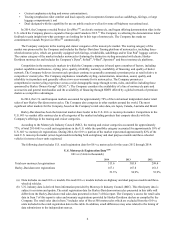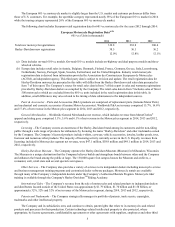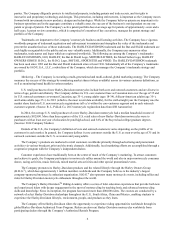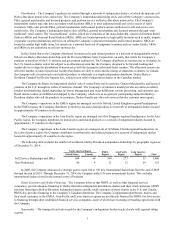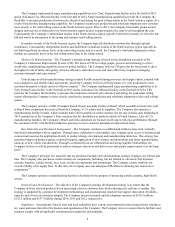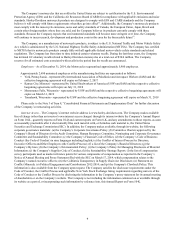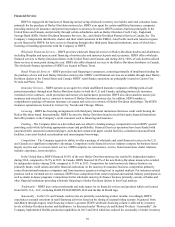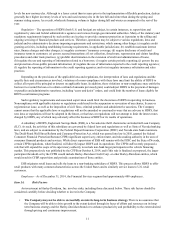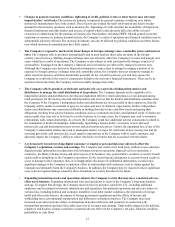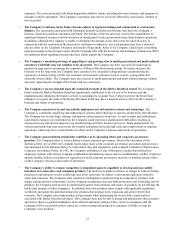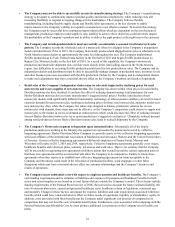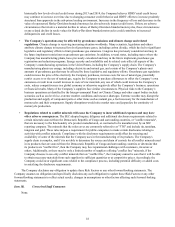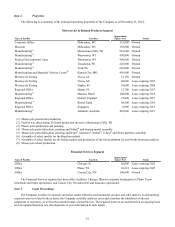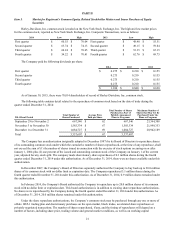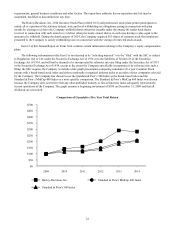Harley Davidson 2014 Annual Report Download - page 14
Download and view the complete annual report
Please find page 14 of the 2014 Harley Davidson annual report below. You can navigate through the pages in the report by either clicking on the pages listed below, or by using the keyword search tool below to find specific information within the annual report.
impacts.€Congress detailed some significant changes, but the Dodd-Frank Act leaves many details to be determined by
regulation and further study. The full impact will not be fully known for years, as regulations that are intended to
implement the Dodd-Frank Act are adopted by the appropriate agencies, and the text of the Dodd-Frank Act is
analyzed by impacted stakeholders and possibly the courts.€The Dodd-Frank Act also created the Consumer Financial
Protection Bureau (CFPB), housed in the Federal Reserve. The CFPB has been granted significant enforcement and
rule-making authority in the area of consumer financial products and services. The direction that the CFPB will take,
the regulations it will adopt, and its interpretation of existing laws and regulations are all elements that are not yet
known. Compliance with the law may be costly and could affect operating results as the implementation of new forms,
processes, procedures and controls and infrastructure may be required to comply with the regulations. Compliance
may create operational constraints and place limits on pricing. Failure to comply with these regulations, changes in
these or other regulations, or the imposition of additional regulations, could affect HDFS’ earnings, limit its access to
capital, limit the number of loans eligible for HDFS securitization programs and have a material adverse effect on
HDFS’ business and results of operations. The CFPB staff recently proposed a rule that would expand the scope of its
supervisory authority to include non-bank larger participants in the vehicle financing market. The CFPB published this
proposed rule on October 8, 2014, and if this rule is finalized as proposed, the larger participant threshold set by the
CFPB would include Harley-Davidson Credit Corp. and other Harley-Davidson entities, which would result in CFBP
supervision and periodic examinations of those entities.
U.S. Public Company - The Company is also subject to policies and actions of the SEC and New York Stock Exchange
(NYSE). Many major competitors of the Company are not subject to the requirements of the SEC or the NYSE rules.
As a result, the Company may be required to disclose certain information that may put the Company at a competitive
disadvantage to its principal competitors.
•The Company relies on third party suppliers to obtain raw materials and provide component parts for use in
the manufacture of its motorcycles. The Company may experience supply problems relating to raw materials and
components such as unfavorable pricing, poor quality, or untimely delivery. In certain circumstances, the Company
relies on a single supplier to provide the entire requirement of a specific part, and a change in this established supply
relationship may cause disruption in the Company’s production schedule. In addition, the price and availability of raw
materials and component parts from suppliers can be adversely affected by factors outside of the Company’s control
such as the supply of a necessary raw material or natural disasters. Further, Company suppliers may experience
difficulty in funding their day-to-day cash flow needs because of tightening credit caused by financial market
disruption. In addition, adverse economic conditions and related pressure on select suppliers due to difficulties in the
global manufacturing arena could adversely affect their ability to supply the Company. These supplier risks may have
a material adverse effect on the Company’s business and results of operations.
•The Company must prevent and detect issues with its products, components purchased from suppliers, and its
and its suppliers’ manufacturing processes to reduce the risk of recall campaigns, increased warranty costs or
litigation, increased product liability claims or litigation, delays in new model launches, and inquiries or
investigations by regulatory agencies.€The Company must also complete any recall campaigns within cost
expectations.€The Company must continually improve and adhere to product development and manufacturing
processes, and ensure that its suppliers and their sub-tier suppliers adhere to product development and manufacturing
processes, to ensure high quality products are sold to retail customers.€If product designs or manufacturing processes
are defective, the Company could experience delays in new model launches, product recalls, inquiries or investigations
from regulatory agencies, warranty claims, and product liability claims, which may involve purported class
actions.€While the Company uses reasonable methods to estimate the cost of warranty, recall and product liability costs
and appropriately reflects those in its financial statements, there is a risk the actual costs could exceed
estimates.€Further, selling products with poor quality and the announcement of recalls may also adversely affect the
Company’s reputation and brand strength.
•The Company relies on third parties to perform certain operating and administrative functions for the
Company. Similar to suppliers of raw materials and components, the Company may experience problems with
outsourced services, such as unfavorable pricing, untimely delivery of services, or poor quality. Also, these suppliers
may experience adverse economic conditions due to difficulties in the global economy that could lead to difficulties
supporting the Company's operations. In light of the amount and types of functions that the Company has outsourced,
these service provider risks may have a material adverse effect on the Company's business and results of operations.
•The Company manufactures products that create exposure to product liability claims and litigation. To the
extent plaintiffs are successful in showing that personal injury or property damage result from defects in the design or
manufacture of the Company’s products, the Company may be subject to claims for damages that are not covered by
14


